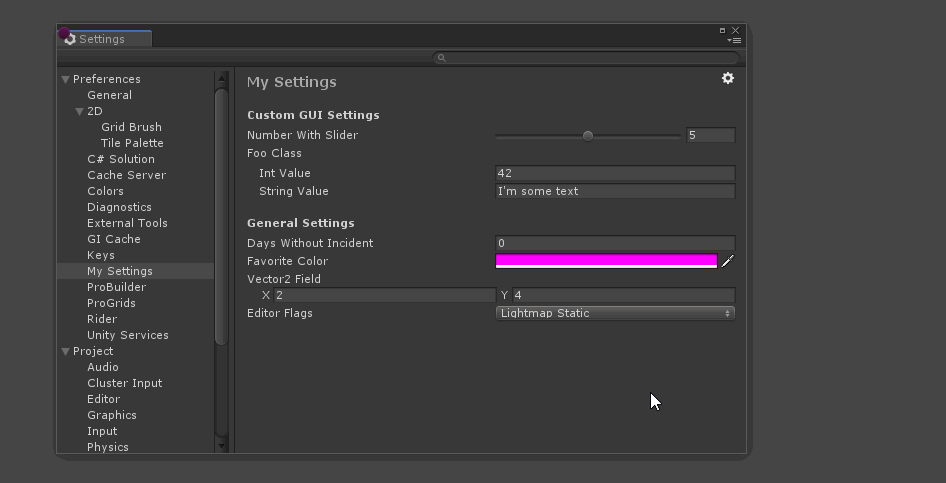# Settings Manager
A framework for making any serializable field a setting, complete with an procedurally populated Settings Provider.

## Quick Start
Settings are saved in `ISettingsRepository` instances. Two default implementations are provided, one for saving user settings (`UserSettingsRepository`) and one for per-project settings (`ProjectSettingsRepository`). Settings repositories are responsible for saving and loading preferences.
You may work directly with `ISettingsRepository`, or create a `Settings` instance to manage them. Creating a `Settings` is convenient because it allows you to make use of the `UserSetting` class and attribute.
The most common case will be for packages to create a `Settings` manager with two repositories, one for user settings (`SettingsScope.User`) and one for per-project settings (`SettingsScope.Project`).
Below is an example of how most packages will use this api.
```
using UnityEditor;
using UnityEditor.SettingsManagement;
using UnityEngine;
public class MySettings
{
static Settings s_SettingsInstance;
public static Settings instance
{
get
{
if(s_SettingsInstance == null)
s_SettingsInstance = new Settings("com.unity.my-package");
return s_SettingsInstance;
}
}
// Register a new SettingsProvider that will scrape the owning assembly for [UserSetting] marked fields.
[SettingsProvider]
static SettingsProvider CreateSettingsProvider()
{
var provider = new UserSettingsProvider("Preferences/My Settings",
instance,
new [] { typeof(MySettings).Assembly });
return provider;
}
}
public class Test
{
[UserSetting("User Settings", "My User Int Value")]
static UserSetting<int> userSetting = new UserSetting<int>(MySettings.instance, "MyInteger", 42, SettingsScope.User);
[UserSetting("Project Settings", "My Project Int Value")]
static UserSetting<int> projectSetting = new UserSetting<int>(MySettings.instance, "MyInteger", 42, SettingsScope.Project);
[MenuItem("Debug/Print Settings Values")]
static void PrintValues()
{
Debug.Log($"User integer is: {(int) userSetting}, and project integer is {(int) projectSetting}");
}
}
```
Values are set and retrieved using generic methods on on your `Settings` instance:
```
MySettingsManager.instance.Get<float>("myFloatValue", SettingsScopes.Project);
```
The `Settings` class will handle finding an appropriate `ISettingsRepository` for the scope (and optional repository name), while `key` and `T` are used to find the value. Setting keys are unique among types, meaning you may re-use keys as long as the setting type is different.
```
// UserSetting<T> is a wrapper class that handles saving and loading serializable values. It is compatible with the `[UserSetting]` attribute, which is used to automatically populate a settings provider.
UserSetting<int> myIntValue = new UserSetting<int>(MySettingsManager.instance, "MyIntegerKey", 42, SettingsScopes.User);
```
`UserSetting<T>` caches the current value, and keeps a copy of the default value so that it may be reset. `UserSetting<T>` fields are also eligible for use with the `[UserSetting]` attribute, which lets the `UserSettingsProvider` automatically add it to a settings inspector.
## Settings Provider
To register your settings in the `Settings Window` you can either write your own `SettingsProvider` implementation, or use the provided `UserSettingsProvider` and let it automatically create your interface.
Making use of `UserSettingsProvider` comes with many benefits, including a uniform look for your settings UI, support for search, and per-field or mass reset support.
```
using UnityEngine;
namespace UnityEditor.SettingsManagement.Examples
{
static class MySettingsProvider
{
[SettingsProvider]
static SettingsProvider CreateSettingsProvider()
{
var provider = new UserSettingsProvider("Preferences/My Settings",
MySettingsManager.instance,
new [] { typeof(MySettingsProvider).Assembly });
return provider;
}
}
}
```
To register a field with `UserSettingsProvider`, simply decorate it with `[UserSetting(string displayCategory, string key)]`. `[SettingAttribute]` is only valid for static fields.
For more complex settings that require additional UI (or simply don't have a built-in editor), you can use `UserSettingBlockAttribute`. This provides access to the settings provider GUI. See `SettingsExamples.cs` for more on this.